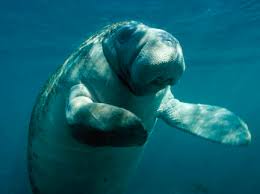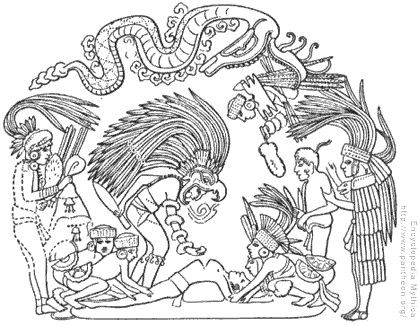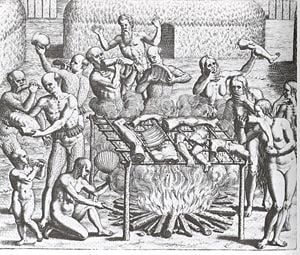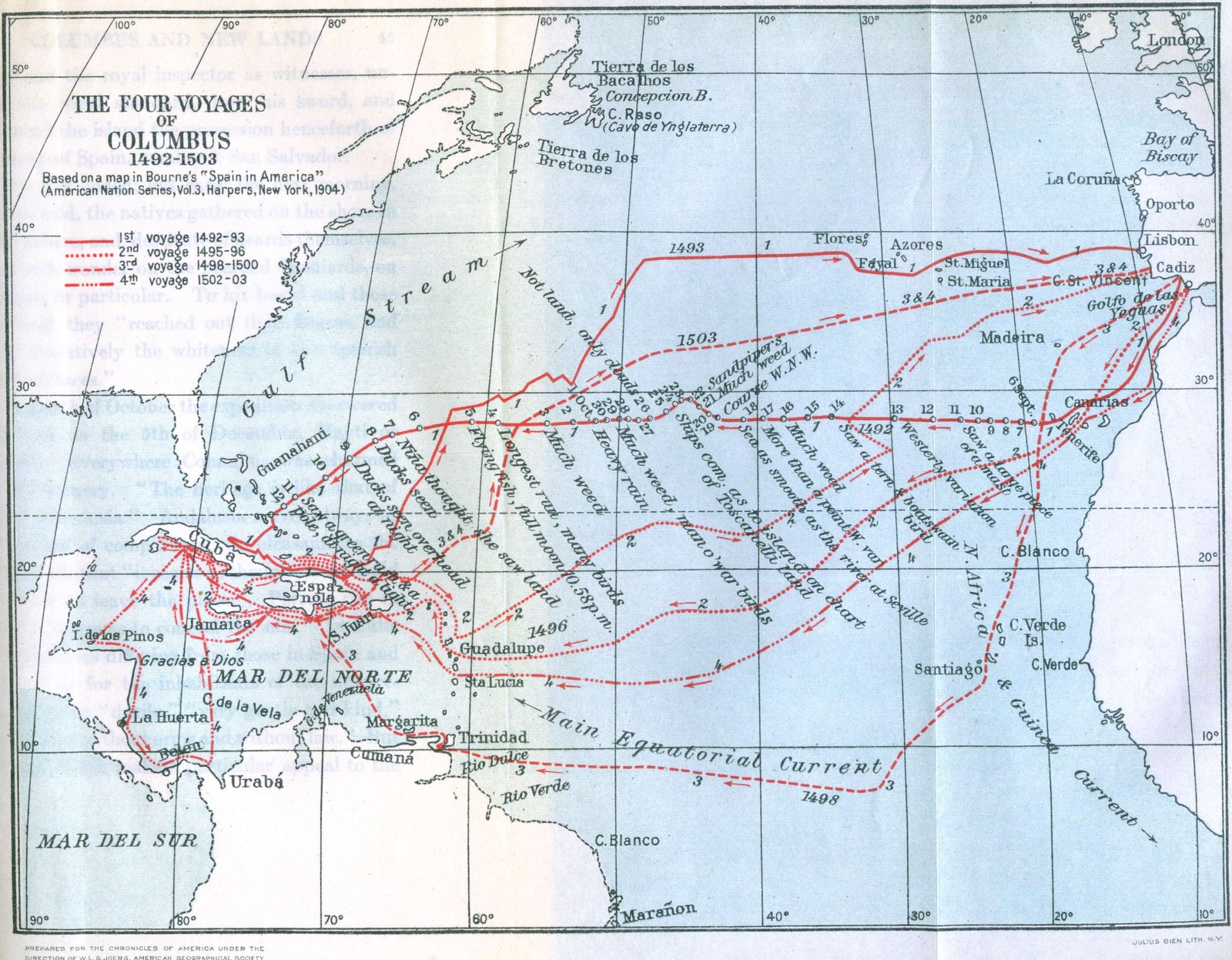If someone asked you to describe what you think the natives of the new world looked like, the kind of shelters they lived in, what their clothing looked like, what would you say? Would you describe naked heathens who lived in huts. If you did you'd only be partially correct.
(Image from the movie The New World by Terrence Malick)
There was another side to the new world that included civilizations who had built cities, erected grand monuments, written books, were fully clothed in beautiful garments and jewelry, and valued scholars and knowledge as much as the neighboring cannibals valued chaos and war. Of course now that 2012 is upon us you may already have recognized the culture of which I speak, the Mayans.
(Photo: Hansjoerg Klein-The Pyramid at Tikal)
In 'the Eight Decades' I have read the first written accounts in English of Mayan civilization. The Spaniards were amazed to find that the Mayans were not only amiable and welcoming but also very intelligent (arguably more so than most of the sailors who first encountered them.) Apparently upon landing at the shore of the Yucatan the Spaniards were greeted by natives. With no interpreter present the Spaniards tried to glean the name of the land by gestures to which the natives replied "Yucatan, Yucatan." The Spaniards assumed this was the name and it has been called that ever since. However, 'Yucatan' in the native tongue meant roughly "I do not understand you." The actual name of the land according to the natives who lived there was Eccampi.
It is a sad fact that contact with the Spaniards brought about as much destruction as construction. Libraries of books were destroyed by Bishop Diego de Landa, a nasty little book burner brought to the Yucatan to teach the natives about the Catholic Church.
He gained the trust of the Mayans by showing interest in their culture and heritage. They allowed him to view their sacred texts, which he then had burned deciding that they were full of nothing but superstition and the devil. The number of books burned is argued over, some say thousands others say a more exact figure of 27, but even if it was just one, oh what a loss! Only 3 or 4 books survived. The Mayans tried to recoup their losses by rewriting from memory what they could but just imagine if someone burned the only copy of the bible and it then had to be rewritten by memory. All those teachings and observations done by different people over years and years...the amount lost would be unimaginable. Thus it was this way with the Mayans.
But wait! What would a history lesson be without a little blood? And as in all stories pertaining to the new world, there will be blood.
As fabulously advanced as the Mayans were, they still believed in the seemingly primitive act of human sacrifice. Sacrificing boys and girls to the creator was a regular practice done at harvest time and other necessary times of the year.
(Image: Encyclopedia Mythica)
Boys and girls were encouraged to volunteer for such a treat and if no one did then a slave was taken and fattened up like a Christmas goose before being offered up. The Mayans feared if they didn't do this then the creator would let loose a plague of locusts (they pop up all over the place don't they?) or hail on them destroying their crops. An odd correlation between that belief and the Christian belief of revelation don't you think? Considering this civilization was completely separated from the bible and yet both believe in a creator who wanted proper adoration or else humans should feel the wrath!
On a lighter note, the Spaniards did observe a baptismal like practice amongst the Mayans. At the age of one year boys and girls were carried to the temple in a grand ceremony where they were then sprinkled with water over there heads.
To be continued...
Share
Monday, November 30, 2009
Wednesday, November 11, 2009
Of Ocean Currents, Pearls and Such
I often wondered why the voyages of early explorers seemed to be so haphazard. Granted, to begin with they didn't have a destination because they didn't even know what, if anything, was out there. But on return voyages it would seem their lines of travel would have a little more purpose and direction. Today I learned why they didn't, or rather why they did but it just didn't look like it.
Ocean currents prevent ships from sailing in a direct line, in fact one current was so strong, near what is modern day Antigua, that it took them the whole day to sale one mile. Yikes, sounds like traffic on 696 :)
This fact would be obvious to any modern day sailor, and I confess I did know about ocean currents I just never gave a second thought to how they affected travel, only to how they affect the weather.
(image courtesy of learner.org) It's dizzying isn't it? Makes me feel like I'm being flushed down a toilet.
Amidst these choppy waters was a group of Islands referred to as the Margarita (this is how it was written in the book), which is the latin form of the Greek word Margarites meaning 'pearl' (that's for you my dear sister-in-law:) This island was so full of pearls that it drove the Spaniards nuts and they would send home barrels of them weighing hundreds of pounds to the King and Queen. HUNDREDS of pounds! The natives of course didn't care because pearl and gold held no value to them other than ornamental. Plus there were so many they knew the Spaniards couldn't possibly deplete the supply...right?
Moving on, today I learned of a species of giant fish called Manati by the natives. There was a story of a fisherman who caught a baby manatu in his net. Apparently these creatures were very intelligent and loved the company of men, so the fisherman kept this particular one, feeding him Yucca and special bread for several days at which time he put the Manatu, which he now called Manu, into the lake by his house. From then on whenever the natives would go to the shore and call out to him he would come up hoping for yucca or some other treat.
If you hadn't figured it out from the get go this animal was actually a Manatee:) I'm embarrassed to say despite the obvious phonetic relationship between the words and the spelling being essentially the same it took me a while to figure this out. The description of the animal was as follows; a large animal like an elephant, shaped like a turtle but without a shell and with a head like a bull. I spent so much time trying to imagine if they were describing the Loch Ness monster I couldn't see the answer staring me in the face:) Deep in my research was I;) My mind is way too sci-fi for it's own good, but I digress...

Who wouldn't want one of these?
This cute sidebar is a rare occurrence in the chronicles of the new world. Martyr goes on to talk about how the natives, despite the king having declared them all free, were still being forced to work in the gold mines and, being unnaccostomed to hard labor, were dying in large numbers. Those that didn't die were either extremely ill or took drastic measures (women used herbs to induce abortion so their children would not be forced to live a life of servitude.)
It isn't known for sure what the original population of Haiti and Cuba were, estimates of 12 million seem unlikely, but whatever it was 25 years after the Spaniards arrival the population had shrunk to 14,000. Between 1507-1513 it shrank from that to 4,000, and by the year 1750 not a single native remained. (MacNutt, 1912) They essentially were worked into near extinction. I say near because even though it is stated not a single native remained many of the Spaniards took native brides and had children. So they live on in that sense.
Before you feel too bad about what happened to these people remember, these natives were tortured, extorted, enslaved, murdered, eaten, sacrificed and oppressed by each other long before the Spanish arrived. I only point that out because it would seem a serene place until the Spanish came and ruined it but that's not entirely the case.
While 'bringing Christianity to these poor souls' may have been the mantra of the Spanish the truth was they stayed and conquered for gold, pearls, silver etc...and by doing so at the point of a sword they have forever stamped themselves as oppressors. It doesn't help that they convinced natives the reason they were all getting sick from the diseases the soldiers brought to the new world was because the hadn't converted to Christianity. The story isn't simply black and white but many shades of grey.
(image courtesy of New World Encyclopedia) Sorry if this is disturbing but this is reality. It was not a serene place.
Thus concludes my history lesson for the day. Stay tuned for a change in topic as I post numerous pictures of cute babies:) xoxo
Ocean currents prevent ships from sailing in a direct line, in fact one current was so strong, near what is modern day Antigua, that it took them the whole day to sale one mile. Yikes, sounds like traffic on 696 :)
This fact would be obvious to any modern day sailor, and I confess I did know about ocean currents I just never gave a second thought to how they affected travel, only to how they affect the weather.
(image courtesy of learner.org) It's dizzying isn't it? Makes me feel like I'm being flushed down a toilet.
Amidst these choppy waters was a group of Islands referred to as the Margarita (this is how it was written in the book), which is the latin form of the Greek word Margarites meaning 'pearl' (that's for you my dear sister-in-law:) This island was so full of pearls that it drove the Spaniards nuts and they would send home barrels of them weighing hundreds of pounds to the King and Queen. HUNDREDS of pounds! The natives of course didn't care because pearl and gold held no value to them other than ornamental. Plus there were so many they knew the Spaniards couldn't possibly deplete the supply...right?
Moving on, today I learned of a species of giant fish called Manati by the natives. There was a story of a fisherman who caught a baby manatu in his net. Apparently these creatures were very intelligent and loved the company of men, so the fisherman kept this particular one, feeding him Yucca and special bread for several days at which time he put the Manatu, which he now called Manu, into the lake by his house. From then on whenever the natives would go to the shore and call out to him he would come up hoping for yucca or some other treat.
If you hadn't figured it out from the get go this animal was actually a Manatee:) I'm embarrassed to say despite the obvious phonetic relationship between the words and the spelling being essentially the same it took me a while to figure this out. The description of the animal was as follows; a large animal like an elephant, shaped like a turtle but without a shell and with a head like a bull. I spent so much time trying to imagine if they were describing the Loch Ness monster I couldn't see the answer staring me in the face:) Deep in my research was I;) My mind is way too sci-fi for it's own good, but I digress...

Who wouldn't want one of these?
This cute sidebar is a rare occurrence in the chronicles of the new world. Martyr goes on to talk about how the natives, despite the king having declared them all free, were still being forced to work in the gold mines and, being unnaccostomed to hard labor, were dying in large numbers. Those that didn't die were either extremely ill or took drastic measures (women used herbs to induce abortion so their children would not be forced to live a life of servitude.)
It isn't known for sure what the original population of Haiti and Cuba were, estimates of 12 million seem unlikely, but whatever it was 25 years after the Spaniards arrival the population had shrunk to 14,000. Between 1507-1513 it shrank from that to 4,000, and by the year 1750 not a single native remained. (MacNutt, 1912) They essentially were worked into near extinction. I say near because even though it is stated not a single native remained many of the Spaniards took native brides and had children. So they live on in that sense.
Before you feel too bad about what happened to these people remember, these natives were tortured, extorted, enslaved, murdered, eaten, sacrificed and oppressed by each other long before the Spanish arrived. I only point that out because it would seem a serene place until the Spanish came and ruined it but that's not entirely the case.
While 'bringing Christianity to these poor souls' may have been the mantra of the Spanish the truth was they stayed and conquered for gold, pearls, silver etc...and by doing so at the point of a sword they have forever stamped themselves as oppressors. It doesn't help that they convinced natives the reason they were all getting sick from the diseases the soldiers brought to the new world was because the hadn't converted to Christianity. The story isn't simply black and white but many shades of grey.
(image courtesy of New World Encyclopedia) Sorry if this is disturbing but this is reality. It was not a serene place.
Thus concludes my history lesson for the day. Stay tuned for a change in topic as I post numerous pictures of cute babies:) xoxo
Wednesday, November 4, 2009
A Lesson in History Part Deux
Off to the library today...
The beautiful Clements
I continue to chip away at the remarkable book I'm to write an
essay on.
Today I read more of the third decade. Here is one of the important things I learned:
When the natives ate they used their right hand to eat a piece of maize or bread and at the same time their left hand to eat meat or fish. Having no napkins or cloth with which to wipe their hands they used the soles of their feet, their hips or sometimes...their testicles. Ha ha. Ah the new world, such a wonderous place. How can I work this entertaining morsel into my essay?
More talk today of the fearsome dogs the Spaniards used in war, and sometimes on unruly natives. This is just feeding my fear of dogs by the way. Today however, Martyr gave a little background on the dogs. They were once called Mollosians, an ancestor of what we know as Mastifs, or possibly even Rottweillers, it's not known for sure. Mollosians were fiercly trained dogs in Epirus, a city in ancient Greece, that were used to guard flocks of sheep and also for hunting. Eventually aiding Greeks and Romans in wars and ultimately the Spaniards who I now have the pleasure of studying

Scary eh?
Vasco Nunez used them to rip apart some grossly disfugured ( "dirty and gnarled" as he called them, so that they were "barely recognizable as human") and abusive caciques (village leaders) who had abused their power and had raped many women and terrorized neighboring villages. On this day I say yay for vicious hell hounds!
Peter Martyr, who is the author of all that I'm reading, back tracks a lot. So today, even though I was reading the third decade which was taking place about 1514, Martyr skipped back to tell more of Columbus' 4th voyage in 1502. I love Columbus. Such a misunderstood explorer.
Despite reports to the contrary Columbus was not a violent racist. He was very much a pacifist and tried everything in his power to bring peace to the new world. He was smart enough to know that more could be accomplished if the natives were friends and allies who willlingly shared knowledge and information about the topography of the new world and all it's contents, rather than waste precious time at war with them.
It is unfortunate that the time period and certain circumstances made this impossible at times. Many of the men he left at stations around the newly discovered Islands committed such atrocities that the author (having gleaned all information from Columbus himself) dared not elaborate except to say that they were more savage than the native cannibals. Yes, cannibals...they were rampant in the new world as well.
Columbus had to spend a good deal of time defending himself to Isabella and Ferdinand also, as there was no end to the usurpers who wanted to see him fail and would send letters to the King and Queen claiming falsehoods about poor old Chris. Doing so in person meant sailing all the way back to Spain (around 26 days voyage) and then spending time home followed by stocking up and organizing a return trip.
A map of the four voyages of Columbus
Think of all the valuable time lost, thank God we have modern communications such as cell phones, land lines, e-mail, UPS, Fedex etc :)
And that concludes my short history lesson for the day. xoxo ;)

My view on the way to my car. Even on a dreary day like today it's still a beautiful.
Tuesday, November 3, 2009
Trick or Treat
There was a little cloud of sadness over me Saturday as I walked my two sons house to house continuing the time honored tradition of trick or treating. They had a great time, Desmond riding in the stroller for much of the trip and Miles walking away from every house stating "My bags not full yet momma, it's not full." The cuteness of these statements did nothing to keep me from seeing my own life flash before my eyes as my 3 year old walked up the steps to a house I once had slumber parties at.
You see, we went to the neighborhood I trick or treated in as a child. I loved that I could do that but at the same time felt a little grief stricken as I realized how quickly the time had gone by since then. I don't feel like it was that long ago that I stayed the night at the Robb's or walked to the Erskine's from my best friend Nikki's house. I don't feel like it was that long ago that Miles was too little to trick or treat for that matter.
But alas, those days are behind me. And happily there are still a few parents living in those beloved houses, proof that those days really did exist even though they may seem like a far away dream now.
Buzz and Woody
Here he is telling me his bag isn't full. Of course he didn't realize Matt was periodically dumping his goods into Desmond's bag so that it wouldn't be too heavy to carry.
Daddy flying Buzz to the next house:)
Despite my mood swings ;) it was a great Halloween. Now, what to do with all this candy?
Subscribe to:
Posts (Atom)












